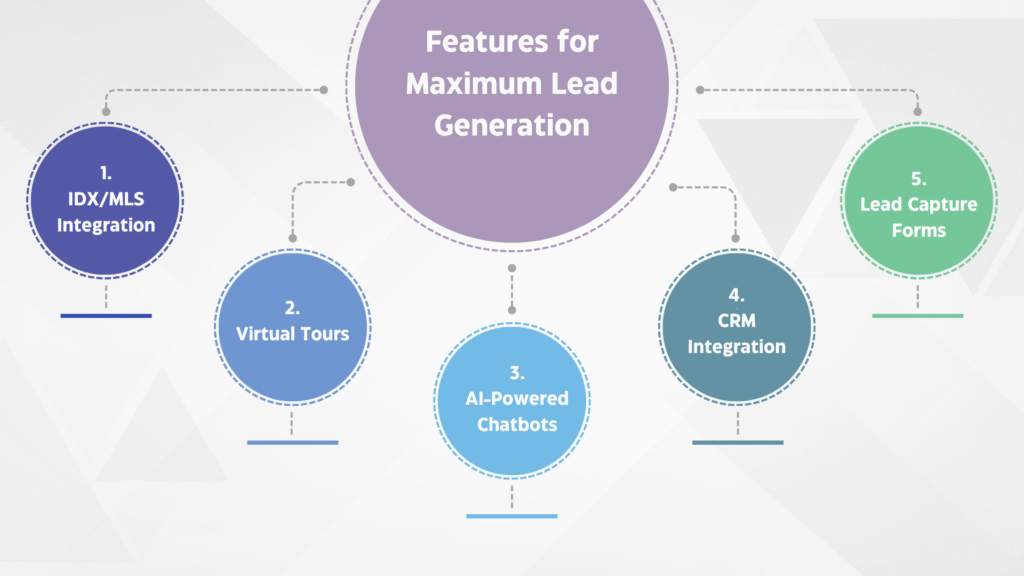Generate More Leads with the Launch of a Real Estate App


The real estate app market is booming, with more buyers and sellers turning to mobile solutions for property searches. Thanks to smartphone adoption and advanced tech like AI and virtual tours, these apps are becoming essential tools for agents and brokers. In fact, the market is expected to grow by 10.4% annually through 2032.
Lead generation is the lifeblood of real estate—without a steady stream of potential buyers and sellers, closing deals becomes much harder. Yet, traditional methods like cold calls and open houses are losing effectiveness, while digital leads now drive over 60% of conversions.
A well-designed real estate app can transform lead generation by offering 24/7 access, instant notifications, and AI-powered tools. Stats show that 61.7% of online buyers eventually convert over the phone, proving that blending digital convenience with personal follow-ups is key. With the right features, your app can attract, engage, and convert more leads than ever before.
A real estate app ensures that buyers and sellers can browse properties anytime, removing the limitations of office hours. Whether it’s late-night searches or weekend browsing, users can explore listings at their convenience, leading to higher engagement and more potential leads. The easier it is for users to access information, the more likely they are to take the next step—whether that’s scheduling a viewing or contacting an agent.
Today’s property searches are increasingly mobile-driven, with over 60% starting on smartphones. A well-optimized app caters to this behavior, offering a seamless experience that desktop websites often can’t match. By meeting users where they already are—on their phones—you capture more leads naturally, without relying solely on traditional marketing methods.
A smooth, intuitive app design keeps users engaged longer, reducing bounce rates and increasing the chances of conversion. Features like easy navigation, fast loading times, and visually appealing layouts make the property search process enjoyable, encouraging users to return frequently. The longer they stay, the more likely they are to convert into qualified leads.
Advanced search filters, interactive maps, and AI-driven recommendations help users find properties faster, eliminating frustration. Instead of scrolling endlessly, buyers get personalized suggestions based on their preferences, saving time and improving satisfaction. A positive experience builds trust, making users more likely to reach out when they’re ready to buy or sell.
Push notifications act as a direct line to potential buyers, delivering real-time updates on price drops, new listings, and open houses. Unlike emails that often go unread, push alerts have a 50%+ higher engagement rate, ensuring your messages get noticed. This instant communication keeps your brand top-of-mind and prompts immediate action.
Timely notifications also re-engage inactive users, bringing them back into the app. For example, if a user saved a search for “3-bedroom homes,” a push alert about a new matching listing can reignite their interest. This level of proactive engagement turns casual browsers into serious leads, boosting conversion rates without extra effort.
AI-powered chatbots provide instant responses to user queries, even outside business hours. Whether answering FAQs or scheduling viewings, these virtual assistants improve customer service while capturing lead details automatically. This ensures no opportunity slips through the cracks, even when agents are unavailable.
Automated lead qualification tools, such as quizzes or behavior-based scoring, help prioritize high-intent leads. By tracking which properties users view, how long they spend on listings, and whether they save favorites, the app can identify hot prospects and alert agents for timely follow-ups. This smart filtering saves time and maximizes conversion potential.

Nothing frustrates potential buyers more than outdated property listings. IDX/MLS integration ensures your app always displays accurate, real-time data directly from the Multiple Listing Service. This keeps users engaged because they know they’re seeing the latest available homes, reducing frustration and drop-offs.
When buyers trust that your app provides reliable information, they’re more likely to keep using it—and eventually reach out to an agent. Fresh listings also encourage repeat visits, increasing the chances of converting casual browsers into serious leads.
Static photos just don’t cut it anymore. Buyers want immersive experiences, and 3D walkthroughs or video tours give them exactly that. These features allow users to explore properties from their couch, making the search process more engaging and convenient.
Research shows that listings with virtual tours keep buyers engaged five times longer than those with only photos. The more time users spend exploring a property, the more emotionally invested they become—boosting the likelihood they’ll schedule a real-life viewing or contact an agent.
Buyers often have questions outside of business hours, and AI chatbots ensure they get instant answers—anytime. These smart assistants can handle FAQs, schedule viewings, and even collect lead details, ensuring no potential client slips away.
Beyond just answering questions, chatbots can qualify leads by asking key questions like budget and timeline. This helps agents focus on the most promising prospects, saving time and increasing conversion rates.
Capturing leads is just the first step—nurturing them is where the real magic happens. CRM integration automatically syncs user data, allowing agents to track behavior (like saved searches or viewed listings) and send personalized follow-ups.
Automated email or SMS sequences can remind users about homes they liked, share similar listings, or offer market updates. This keeps your brand top-of-mind and gently guides leads toward making a decision.
Long, complicated forms scare users away. Instead, keep lead capture forms short—just name, email, and phone number—to maximize submissions. Pair them with clear, compelling CTAs like “Schedule a Viewing” or “Get a Free Valuation” to prompt immediate action.
Strategic placement matters too. CTAs should appear at key decision points, such as after a virtual tour or when a user revisits a listing multiple times. The easier you make it for users to take the next step, the more leads you’ll generate.
Don’t let potential leads slip away—use retargeting ads to reconnect with users who browsed your app but didn’t convert. Platforms like Facebook and Instagram offer lead ads that integrate directly with your app, making it easy for users to submit inquiries without leaving their social feed.
Keep leads warm with automated, behavior-based follow-ups. If a user viewed a property, send them similar listings via email or text. This tailored approach keeps your brand top-of-mind and gently nudges prospects toward a decision.
Make sure your app appears when buyers search “homes for sale near me.” Optimize for local keywords and voice search, as more users ask Alexa or Google Assistant for property recommendations.
Turn happy users into brand advocates by rewarding referrals with discounts or cash incentives. Add gamification—like points for app engagement—to encourage repeat usage and sharing.
Track how many app-generated leads actually convert into closed deals. In real estate, only 0.4% to 2.4% of leads typically convert to sales, so this metric helps gauge your app’s effectiveness at driving transactions versus just generating interest.
Monitor two key behaviors:
Average session duration (aim for 3+ minutes)
Property views per user (5+ views suggests serious buyers)
These reveal whether users are genuinely exploring listings or just casually browsing.
Strong apps retain 25-40% of users weekly. Also track:
Push notification open rates (industry avg: 4-10%)
Return visits per month
High numbers indicate your app stays relevant between property searches.
Compare acquisition costs:
Paid ads: $20-$50/lead
Organic app traffic: Often under $5/lead
Focus on which sources deliver leads that actually close, not just sign-ups.
Ylopo stands out by using artificial intelligence to nurture leads through Facebook and Google ads. Their system automatically identifies potential buyers based on behavior, ensuring ads reach the right audience. This smart targeting reduces wasted ad spend and brings in higher-quality leads.
Once leads come in, Ylopo’s automated texting keeps them engaged. The platform integrates with CRMs, so agents get real-time updates on lead activity. This means faster follow-ups and more conversions—proving that AI can handle the early stages of lead nurturing efficiently.
The results speak for themselves. Agents using Ylopo see higher conversion rates because the system prioritizes hot leads. With features like behavioral alerts and long-form messaging funnels, Ylopo helps turn casual browsers into serious buyers.
CINC combines hyperlocal ads with IDX-powered websites to attract nearby buyers. Their ads target users searching for homes in specific neighborhoods, increasing the chances of finding ready-to-move prospects. This precision marketing cuts through the noise of generic real estate ads.
The platform uses AI to route leads to the best-matched agents instantly. No more waiting—hot leads get immediate attention, improving response times. CINC also tracks lead behavior, so agents know exactly when to follow up for maximum impact.
By blending smart ads with seamless CRM integration, CINC helps agents close more deals. Their approach proves that hyperlocal targeting and automation can supercharge lead conversion.
Lofty’s strength lies in its customizable CRM, which syncs with MLS listings for up-to-date property data. Agents can manage leads effortlessly while staying on top of new inventory. This saves time and keeps the sales pipeline moving smoothly.
The platform automates follow-ups across email, SMS, and calls. If a lead views a property, Lofty sends personalized recommendations—keeping the conversation going without manual effort. This consistent engagement increases the odds of conversion.
With Lofty, agents spend less time on admin and more time closing deals. Its automated yet personalized approach shows how technology can enhance real estate sales without losing the human touch.
A well-designed real estate app is a powerful lead generation tool, offering 24/7 accessibility, AI-powered automation, and personalized engagement. By integrating features like virtual tours, instant messaging, and CRM syncs, agents can attract, nurture, and convert more leads efficiently.
However, success doesn’t stop at launch. Continuous optimization—tracking KPIs, refining user experience, and adopting emerging trends like voice search and AR—ensures your app stays competitive. In a fast-evolving market, staying ahead with technology is key to turning prospects into loyal clients. Invest in innovation, and your app will become an indispensable asset for growth.
Monacgo: 7/1253 Subramania Siva Street, NGO colony, Nagamalaipudukottai, Madurai – 625019, Tamil Nadu, India.
Mobile: +91 9789308131
Monacgo: 403 Starkweather Ave, Cleveland, OH 44113, United States
Mobile: +1 (585) 632-0256
Email: support@zipprr.com
Disclaimer: The keywords Gojek, Airbnb, Uber, UberEats, UrbanClap, Amazon, Carousell, ChatGPT, Youtube, Facebook, Turo, Practo, TaskRabbit, TikTok, Udemy, Whatsapp, Tinder and Letgo are solely used for marketing purposes, and we are not associated with any of the mentioned companies in any form. The source code and design of our products are fully owned by sellers. We are not using any of their copyrighted materials.
© 2025 Zipprr. All rights reserved.
